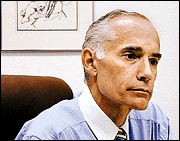Advertisement - Click to support our sponsors.


![]()
View Point
SINCE my arrival in Hawaii in 1999, there have been many references to the "economic engine" that I believe the University of Hawaii's John A. Burns School of Medicine can become. UH medical school
can be an engineThe biomedical world is an esoteric one, and the funding mechanisms may not be familiar to many. So I'd like to explain the way an "economic engine" is created in a university medical school setting.
A key source of funding for a typical medical school where major research is conducted is through federal grants from the National Institute of Health (NIH). Hawaii is not currently receiving its share of this national funding source.
This past year, our medical school only received $1.8 million when, this year, the NIH has $18 billion to support to research projects, both clinical and basic sciences. This federal spending could double within the next five years.
The way for the UH medical school to gain access to NIH funds is to hire faculty researchers with projects that are currently supported by this funding, and to recruit young faculty with new ideas who can be competitive for these dollars.
The NIH recognizes that there are infrastructure costs associated with research (building depreciation and maintenance, grant administration, utilities, etc.). They provide additional funding (overhead recovery) to support these costs, thus ensuring that research will be carried out in an appropriate environment.
In the case of UH, the overhead recovery rate is 35 percent. A grant of $1 million would also bring with it an additional $350,000 annually.
The grants these researchers bring to Hawaii also create new jobs for research assistants and support staff. By attracting top researchers, we begin to build the "economic engine" that we know this school can become.
In addition to NIH funding, there are billions of dollars available annually to support research from private foundations and organizations such as the American Cancer Society, March of Dimes, American Heart Association, American Diabetes Foundation, Muscular Dystrophy Foundation and others.
Moreover, all pharmaceutical companies support research at medical centers that can best be done in that environment.
A distinguished research faculty serves as a catalyst and support system for the new biotech companies which Hawaii is seeking to attract. These faculties are both physicians and scientists and will enhance our educational programs for all our students.
MY economic model for the Burns School of Medicine includes recruiting 15 new faculty at a cost of $3.6 million. We anticipate that each new faculty member will, on average, bring to Hawaii $1 million in grant or contract income annually, for a total of $15 million.
The NIH overhead recovery of 35 percent would total $5.25 million more in revenue.
Therefore, for an investment of $3.6 million in 15 faculty, the revenue generated is $20.25 million -- a leverage factor of 5.623 on our initial investment.
Even if each faculty member brought in only half the predicted amount -- or $500,000 -- the model still predicts annual revenue of $10.13 million to the UH medical school.
I am confident that this model is workable and would allow the medical school to contribute to Hawaii's economy and be less dependent on local legislative funding.
Our financial goal is self-sufficiency; our academic goal is recognition as the best medical school in the world with an Asian-Pacific focus.
Edwin C. Cadman, M.D., is dean of the John A. Burns
School of Medicine at the University of Hawaii at Manoa.